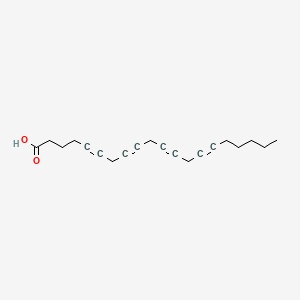| Sergeeva M et al. |
Arachidonic acid and docosahexaenoic acid suppress thrombin-evoked Ca2+ response in rat astrocytes by endogenous arachidonic acid liberation. |
2002 |
J. Neurochem. |
pmid:12358772
|
| Holk A et al. |
Molecular identification of cytosolic, patatin-related phospholipases A from Arabidopsis with potential functions in plant signal transduction. |
2002 |
Plant Physiol. |
pmid:12226489
|
| Pati D and Habibi HR |
Involvement of protein kinase C and arachidonic acid pathways in the gonadotropin-releasing hormone regulation of oocyte meiosis and follicular steroidogenesis in the goldfish ovary. |
2002 |
Biol. Reprod. |
pmid:11870090
|
| Griffiths C et al. |
Nitric oxide inactivation in brain by a novel O2-dependent mechanism resulting in the formation of nitrate ions. |
2002 |
Biochem. J. |
pmid:11853555
|
| PachernÃk J et al. |
Multiple biological effects of inhibitors of arachidonic acid metabolism on human keratinocytes. |
2002 |
Arch. Dermatol. Res. |
pmid:11875646
|
| Alaoui-El-Azher M et al. |
Arachidonic acid differentially affects basal and lipopolysaccharide-induced sPLA(2)-IIA expression in alveolar macrophages through NF-kappaB and PPAR-gamma-dependent pathways. |
2002 |
Mol. Pharmacol. |
pmid:11901217
|
| Soldati L et al. |
Arachidonic acid increases intracellular calcium in erythrocytes. |
2002 |
Biochem. Biophys. Res. Commun. |
pmid:12051755
|
| Ito Y et al. |
Exercise training increases membrane bound form of tumor necrosis factor-alpha receptors with decreases in the secretion of soluble forms of receptors in rat adipocytes. |
2002 |
Life Sci. |
pmid:12052444
|
| Silldorff EP et al. |
Angiotensin II constriction of rat vasa recta is partially thromboxane dependent. |
2002 |
Hypertension |
pmid:12364360
|
| You J et al. |
Role of cytoplasmic phospholipase A2 in endothelium-derived hyperpolarizing factor dilations of rat middle cerebral arteries. |
2002 |
J. Cereb. Blood Flow Metab. |
pmid:12368663
|
| Shrestha R et al. |
N-acylethanolamines are metabolized by lipoxygenase and amidohydrolase in competing pathways during cottonseed imbibition. |
2002 |
Plant Physiol. |
pmid:12226518
|
| Kintscher U et al. |
PPARalpha inhibits TGF-beta-induced beta5 integrin transcription in vascular smooth muscle cells by interacting with Smad4. |
2002 |
Circ. Res. |
pmid:12456495
|
| Marx N et al. |
PPARalpha activators inhibit tissue factor expression and activity in human monocytes. |
2001 |
Circulation |
pmid:11208679
|
| Lefevre P et al. |
Effects of polyunsaturated fatty acids and clofibrate on chicken stearoyl-coA desaturase 1 gene expression. |
2001 |
Biochem. Biophys. Res. Commun. |
pmid:11162472
|
| Fiorio Pla A and Munaron L |
Calcium influx, arachidonic acid,and control of endothelial cell proliferation. |
2001 |
Cell Calcium |
pmid:11587547
|
| Mamas MA and Terrar DA |
Actions of arachidonic acid on contractions and associated electrical activity in guinea-pig isolated ventricular myocytes. |
2001 |
Exp. Physiol. |
pmid:11445822
|
| Alexander LD et al. |
Arachidonic acid directly activates members of the mitogen-activated protein kinase superfamily in rabbit proximal tubule cells. |
2001 |
Kidney Int. |
pmid:11380805
|
| Holmqvist MH et al. |
Kinetic modulation of Kv4-mediated A-current by arachidonic acid is dependent on potassium channel interacting proteins. |
2001 |
J. Neurosci. |
pmid:11404400
|
| Ghosh S and Natarajan R |
Cloning of the human cholesteryl ester hydrolase promoter: identification of functional peroxisomal proliferator-activated receptor responsive elements. |
2001 |
Biochem. Biophys. Res. Commun. |
pmid:11409902
|
| Park Y and Pariza MW |
Lipoxygenase inhibitors inhibit heparin-releasable lipoprotein lipase activity in 3T3-L1 adipocytes and enhance body fat reduction in mice by conjugated linoleic acid. |
2001 |
Biochim. Biophys. Acta |
pmid:11750884
|
